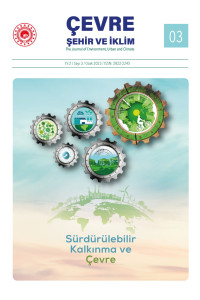Öz
Denizlerde nütrientlerin (besin maddeleri) artışı, su ısısında ani değişimler ve su akıntısının düşük olması alg ve diğer fitoplanktonların önemli ölçüde çoğalmasına neden olmaktadır. Bu mikroorganizmalar deniz salyası olarak tanımlanan şeffaf, yapışkan peltemsi bir madde oluştururlar. Su yüzeyini kaplayan ve sucul ortamda fotosentezin kısmen veya tamamen durmasına neden olan müsilaj örtüsü, sudaki çözünmüş oksijen oranını düşürmektedir. Oksijeni düşen deniz ortamında yaşayan canlılarda toplu ölümler gerçekleşmektedir. Ölen canlıların kalıntılarının da deniz salyasına katılmasıyla birlikte müsilaj bulunduğu ortamda kötü koku yayan bir maddeye dönüşmektedir. Bu durum zaman zaman Marmara Denizi’nde de görülmekte ve ciddi bir çevre problemi oluşturmaktadır. Bu problemin nedenlerini araştırmaya yönelik olarak denize deşarj olan sulardan, deniz salyasından ve deniz suyundan numuneler alınarak gerekli analizler yapılmıştır. Müsilajın pH değeri 6,65-7,12 arasında, deniz suyunun pH değeri ise 7,88-8,25 arasındadır. Analiz sonuçlarına göre müsilaj numunesinin asidik, deniz suyu numunesinin ise bazik karakterde olduğu saptanmıştır. Deniz suyuna azot ve fosfor gübresi katılarak suyun ve müsilajın asitlik durumu izlenmiştir. Bu deneyde müsilaj pH değeri 6,15-6,55’e, deniz suyunun pH değeri ise 7,15-7,25’e kadar düşerek ortamın asitleştiği ve elektrik iletkenliğinin arttığı görülmüştür.
Deniz veya göllerde kirliliğin artmaması için bu ortamlara arıtılmamış sular deşarj edilememeli ve mümkünse deniz suyunun akımı arttırılmalıdır. Marmara Denizi günümüze kadar Çanakkale ve İstanbul boğazlarından gerçekleşen su akımları nedeniyle kendini temizleyebilme yeteneğine sahipti. Fakat son zamanlarda bölgede artan sanayileşme, artan nüfus, gemi trafiğindeki artış ve tarımsal faaliyetlerde kullanılan gübre ve ilaçlamaların artması nedenleriyle Marmara Denizi’ni kirleten ajanlar artmıştır. Bu kirlenme artışları denizin kendini temizleme kapasitesinin üzerinde olup, denizin kirlenmesi kaçınılmazdır. Bu nedenle Marmara Denizi’nin çevre problemlerinin çözümü için denize atık suların deşarj edilmemesi, tarımsal faaliyetlerde ve gemi trafiğinde kontrollerin artırılması hayati önem taşımaktadır. Ayrıca Marmara Denizi’nin su akımının artmasına ve su kirliliğinin seyreltilmesi amacıyla doğal veya yapay su yollarıyla denize temiz su sağlanması da araştırılmalıdır
Anahtar Kelimeler
Müsilaj deniz salyası deniz kirliliği ötrofikasyon Marmara Denizi
Kaynakça
- Yümün, Z.Ü. ve Kam, E. (2021). Marmara Denizi’nde Müsilaj Sorunu ve Çözüm Yöntemleri, Marmara Deniz Ekolojisi; Deniz Salyası Oluşumu, Etkileşimleri ve Çözüm Önerileri, Türkiye Bilimler Akademisi, 2021, 163-185
- Yümün, Z. Ü. (2017). Effects of radionuclides on the recent foraminifera from the clastic. Journal of African Earth Sciences, (1) 179-182.
- Yümün, Z. Ü., Kam, E., Dinçer, A., Önce, M., Yümün, S. (2021). The Investıgatıon Of Toxıc Element Pollutıon And Radıoactıvıty Analyses Of Marıne Sedıments In The Gulf Of Gemlik (Bursa, Turkey). Applied Ecology And Environmental Research, 14751-14765.
- Kam, E. ve Yümün, Z. Ü. (2021). Geographical distribution of toxic elements in Northeast Marmara Sea sediments and analysis of toxic element pollution by various pollution index methods (Istanbul/Turkey). Applied Ecology And Environmental Research, 1869-1893.
- Yümün, Z. Ü. ve Kam, E. (2017). Effects of radionuclides on the recent foraminifera from the clastic. Journal of African Earth Sciences, 179-182.
- Yümün, Z. Ü. ve Önce, M. (2017). Monitoring heavy metal pollution in foraminifera from the Gulf of. Journal of African Earth Sciences, 110-124.
- Keleş, G., Yilmaz, S., Zengin, M. (2020) Possible economic effects of musilage on Sea of Marmara Fisheries. Int J Agric For Life Sci 4(2): 173-177.
- Yıldız T. ve Gönülal O. (2021). Sea snot and its impacts on the fisheries in the Sea of Marmara and its adjacent waters. J. Black Sea/Mediterranean Environment. Vol. 27, No. 2: 167-183.
- Yön Ertuğ N. ve Kayhan F. E. (2022). MÜSİLAJ SORUNU VE KARAKTERİZASYONU. Doğanın Sesi. 5,9, 4-16.
- Yüksek A., Sur H.İ. (2010). First Observation of the Mucilage/Gelatinous Formation in the Sea of Marmara in October 2007. GFCM Workshop on Algal and Jellyfish Blooms in the Mediterranean and Black Sea, Istanbul, Turkey.
- Rodriguez, D. J., Angula-Sanchez, J. L, Silva, J. A. T., & Aguilar-Gonzalez, C. N. (2006) Review of Aloe Species’ Medicinal Properties and Bioactive Compounds. Floriculture, Ornamental and Plant Biotechnology, 4(51), 460-471.
- Wani, M. Y., Hasan, N., Malik, M. A. (2010) Chitosan and Aloe Vera: Two Gifts of Nature. Journal of Dispersion Science and Technology, 31, 799– 811.
- Lancelot, C. (1995). “The mucilage phenomenon in the continental coastal waters of the North Sea”. Science of the Total Environment, 165:83–102.
- Genç N., Durna E., Sayin F. E. (2021). Dewatering of Mucilage Biomass Collected from the Marmara Sea Surface: Optimization of Coagulation and Centrifugation Processes. Aksaray University Journal of Science and Engineering . Vol 5,2, 138-157.
- Özyurt, N. N., Bayarı, S., Doğdu, M. Ş., & Arıkan, A. (2001). Akkuyu Körfezi (Mersin) deniz suyunun fiziksel ve kimyasal özelliklerini etkileyen süreçler. Yerbilimleri, 113-126.
- Mecozzi, M., Pietroletti, M., Scarpiniti, M., Acquistucci, R. & Conti, M.E. (2012). Monitoring of marine mucilage formation in Italian seas investigated by infrared spectroscopy and independent component analysis. Environmental Monitoring Assessment. 184; 6025-6036.
- Breitburg, D.L., Sanders, J.G., Gilmour, C.C., Hatfield, C.A., Osman, R.W., Riedel, G.F., Seitzinger, S.P. (1999). Variability in responses to nutrients and trace elements,and transmission of stressor effects through an estuarine food web. Limnology and Oceanography. 44: 837-863.
- Mackenzie, L., Sims, I., Beuzenberg, V., Gillespie, P. (2002). Mass Accumulation Of Mucilage Caused By Dinoflagellate Polysaccharide Exudates İn Tasmanian Bay, New Zelland, Harmful Algae, 1: 69-83.
- Cozzia, S.,Ivancic, I.,Catalanoa, G.,Djakovacb, T., Degobbis, D. (2004). Dynamics of the oceanographic properties during mucilage appearance in the Northern Adriatic Sea: analysis of the 1997 event in comparison to earlier events. Journal of Marine Systems 50, 223– 241. Elseve Publishers.
- Dell'Amore, C. (2010). "Sea Snot" Explosion Caused by Gulf Oil Spill?". National Geographic.
Ayrıntılar
| Birincil Dil | Türkçe |
|---|---|
| Konular | Çevre ve Kültür |
| Bölüm | Araştırma Makaleleri |
| Yazarlar | |
| Yayımlanma Tarihi | 31 Ocak 2023 |
| Yayımlandığı Sayı | Yıl 2023 Sayı: 3 |


